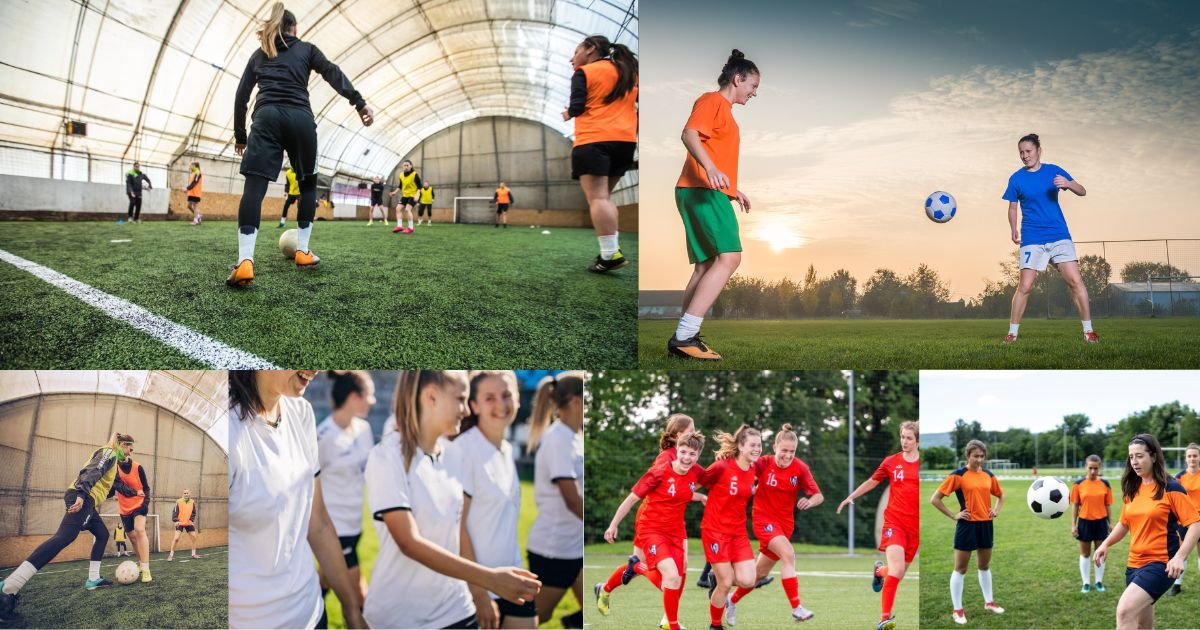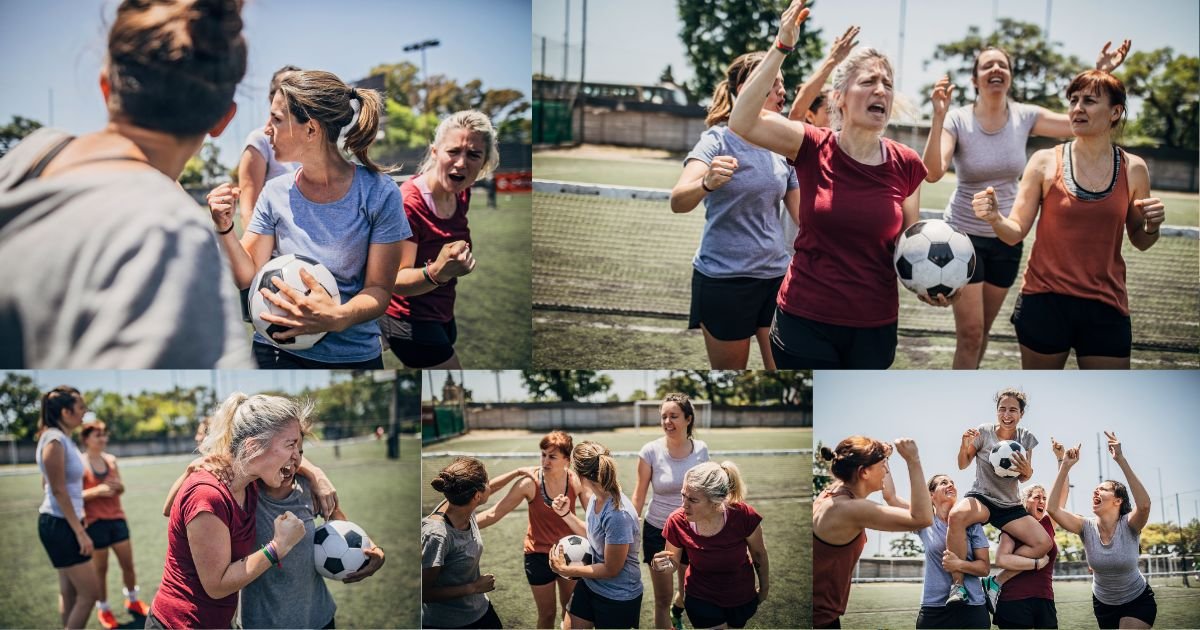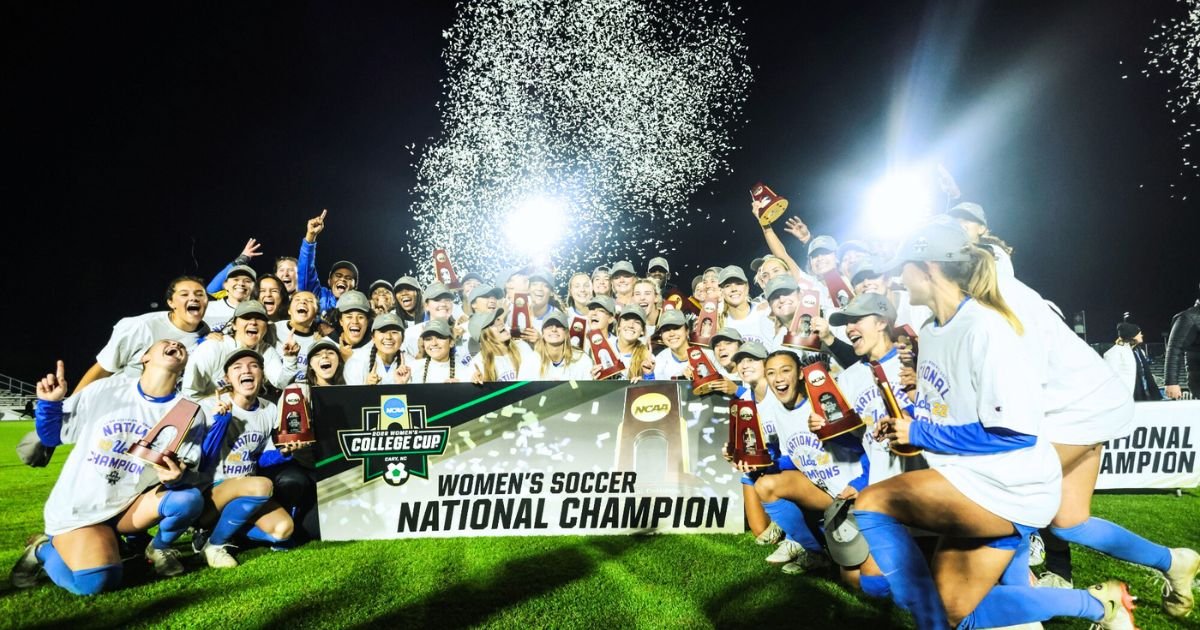Women’s sports have been slowly gaining popularity over the years, and NCAA Women’s Soccer is no exception. The journey to the championship is long and grueling, but it’s also filled with excitement and passion. Women’s soccer is breaking barriers and making history. It’s inspiring young girls all over the world to follow their dreams. In this blog post, we’ll take a closer look at the journey to the NCAA Women’s Soccer Championship, from the hard work and dedication of the players to the support of the fans and the impact it has on society as a whole. So let’s dive in and explore the inspiring journey of these talented athletes changing the game.
Introduction: The significance of the NCAA Women’s Soccer Championship

The NCAA Women’s Soccer Championship is not just a prestigious event in college sports but a significant milestone in the journey toward gender equality in athletics. Over the years, women’s soccer has faced numerous barriers and challenges. Still, the championship serves as a testament to female athletes’ resilience, talent, and determination.
This championship brings together the best collegiate women’s soccer teams nationwide, showcasing their skills and passion. The tournament not only provides a platform for these athletes to compete at the highest level but also serves as an inspiration for young girls who aspire to participate in soccer.
Read More: United States Men’s National Soccer Team
Historically, women’s sports have been overshadowed by their male counterparts, receiving less attention, resources, and recognition. However, the NCAA Women’s Soccer Championship is a shining example of how far the women’s game has come and continues to break barriers.
By highlighting the achievements of these exceptional athletes, the championship challenges societal expectations and stereotypes, demonstrating that women can excel in sports just as much as men. It sends a powerful message to the world that gender should not be an obstacle to pursuing one’s dreams and achieving success.
Join us as we celebrate the triumphs, relive the unforgettable matches, and honor the remarkable individuals who have contributed to the growth and recognition of women’s soccer. Together, let’s break barriers and champion equality in sports.
The history and growth of women’s soccer in the NCAA

The history and growth of women’s soccer in the NCAA is a testament to female athletes’ incredible journey and progress. It all began in 1981 when the first NCAA Women’s Soccer Championship was held. At that time, only 32 teams were competing for the coveted title.
Over the years, women’s soccer in the NCAA has experienced significant growth and recognition. The number of teams participating in the championship has more than tripled since its inception, with over 100 teams now vying for glory each season. This exponential growth demonstrates women’s soccer’s increasing popularity and importance in the collegiate sports landscape.
Furthermore, the skill and athleticism displayed by these talented young women have captivated audiences and shattered stereotypes. The commitment and dedication shown by players and coaches have helped elevate the level of play, making women’s soccer in the NCAA a force to be reckoned with.
Not only has women’s soccer in the NCAA grown in terms of participation, but it has also gained significant support from fans and sponsors. The increasing media coverage and exposure have allowed the sport to reach a wider audience and create a platform for these remarkable athletes to showcase their talent.
The journey to the NCAA Women’s Soccer Championship is a testament to these athletes’ resilience, passion, and determination.To participate at the highest level of collegiate soccer, they had to overcome several obstacles. Their success and achievements have paved the way for future generations of female athletes, breaking down barriers and inspiring young girls to dream big.
As we celebrate the history and growth of women’s soccer in the NCAA, it is important to recognize the remarkable progress and continued efforts to promote gender equality in sports. The journey to the NCAA Women’s Soccer Championship is not just about winning a title but also about breaking barriers and empowering women to reach their full potential on and off the field.
Overcoming gender stereotypes in sports

Gender stereotypes in sports have long been a barrier for women athletes. Still, the journey to the NCAA Women’s Soccer Championship is breaking down those barriers one game at a time. Women have faced numerous challenges throughout history when competing in sports. From being discouraged from participating to being labeled as “too weak” or “not athletic enough,” these stereotypes have hindered the progress of female athletes.
However, the NCAA Women’s Soccer Championship is a testament to the perseverance and resilience of women in sports. These talented athletes have defied societal expectations and shattered glass ceilings, proving that gender should never be a limitation in achieving greatness.
Through years of dedicated training, rigorous competition, and unwavering passion, women soccer players have showcased their remarkable skills and athleticism. Each game is a powerful statement, challenging the notion that women are inferior or less capable than their male counterparts.
The NCAA Women’s Soccer Championship provides a platform where female athletes can showcase their talents and inspire future generations. These women have become role models for young girls, showing them that they can pursue their dreams in sports without limitations.
While challenges still exist, the progress made in overcoming gender stereotypes in sports is undeniable. With increased recognition, support, and opportunities, women’s soccer has gained momentum and is now celebrated nationally.
The journey to the NCAA Women’s Soccer Championship is not just about winning a title; it is about breaking down barriers and paving the way for a future where gender equality in sports is the norm. It is a journey that inspires and empowers, reminding us that determination and resilience can surpass societal expectations.
As we celebrate the achievements of these incredible athletes, let us continue to challenge gender stereotypes and support women in their pursuit of excellence on and off the field. Together, we can create a world where every woman has the opportunity to compete, excel, and make history in the world of sports.
The importance of equal opportunities and resources for women’s soccer teams

The journey to the NCAA Women’s Soccer Championship is not just about the competition on the field but also about breaking down barriers and ensuring equal opportunities and resources for women’s soccer teams.
Women’s sports have been overlooked and undervalued for far too long, with limited resources and support compared to their male counterparts. However, the tides are starting to turn as more people recognize the importance of equal opportunities in sports.
Equal opportunities mean providing women’s soccer teams with the same funding, facilities, coaching staff, and resources as men’s teams. It means creating an environment where female athletes can thrive and reach their full potential.
When women’s soccer teams access the same resources as men’s, it levels the playing field and allows for fair competition. This benefits the individual players and raises the overall standard of women’s soccer.
Moreover, equal opportunities in sports have a broader impact on society. By providing women with the same opportunities to excel in sports, we challenge societal norms and break down gender stereotypes. It sends a powerful message that women can achieve greatness and deserve the same recognition and support as men.
Investing in women’s soccer is about fairness and a wise business decision. The growing popularity and success of women’s soccer have proven that there is a market and a fan base eager to support these athletes. We can tap into this potential by providing equal opportunities and resources and further growing the sport.
The journey to the NCAA Women’s Soccer Championship is not just about winning a trophy but about creating a more inclusive and equitable world for women in sports. It is about giving young girls role models to look up to and inspiring them to chase their dreams without limitations.
As we continue to champion equal opportunities and resources for women’s soccer teams, we take one step closer to a future where gender no longer determines success in sports. Let us break down barriers and pave the way for a more inclusive and equal playing field in soccer.
The challenges faced by women’s soccer teams on the road to the championship

The road to the NCAA Women’s Soccer Championship has its challenges. Women’s soccer teams face unique obstacles and barriers that can make their journey to the championship even more daunting.
One of the biggest challenges women’s soccer teams face is the need for more resources and investment compared to their male counterparts. This often translates into limited facilities, coaching staff, and equipment funding. Despite these athletes’ tremendous talent and dedication, they usually have to make do with less, working twice as hard to achieve the same level of success.
Another challenge is the persistent gender bias and stereotypes surrounding women’s sports. Women’s soccer is often overlooked and undervalued, receiving less media coverage and sponsorship opportunities. This lack of exposure can hinder the growth and development of the sport, making it harder for women’s soccer teams to gain recognition and support.
Read More: USA vs Jamaica: A Rivalry on the Soccer Field
In addition, women’s soccer teams face inclusivity and equal opportunity challenges. The fight for gender equality in sports is ongoing, with issues such as pay disparities, unequal treatment, and limited opportunities still prevalent. These barriers not only affect the athletes themselves but also impact the overall development and future of women’s soccer.
Despite these challenges, women’s soccer teams continue to push forward, breaking barriers and defying odds. They showcase their incredible skills, determination, and passion for the game. Their hard work and perseverance inspire future generations of female athletes to dream big and pursue their goals, ultimately paving the way for a more equitable and inclusive future for women’s soccer.
The journey to the NCAA Women’s Soccer Championship is not an easy one. Still, it is a testament to the strength and resilience of these remarkable athletes. As we celebrate their achievements, let us also recognize the barriers they face and work towards creating a more level playing field for women in sports.
Inspiring stories of teams and players who broke barriers and achieved greatness

Throughout the history of the NCAA Women’s Soccer Championship, there have been numerous inspiring stories of teams and players who broke barriers and achieved greatness. These stories not only showcase these athletes’ incredible talent and determination but also highlight the progress and impact they have made in the world of women’s soccer.
One such story is that of the University of North Carolina’s women’s soccer team. Coached by the legendary Anson Dorrance, the Tar Heels dominated college soccer in the 1980s and 1990s, winning 22 national championships. Their success established a dynasty and paved the way for future generations of female athletes. The team’s commitment to excellence and relentless pursuit of victory inspired countless young girls to dream big and pursue their soccer aspirations.
A former player for the University of North Carolina and the United States Women’s National Team, Mia Hamm has a great story as well. Hamm’s exceptional skills and relentless work ethic earned her numerous awards and accolades, including two World Cup championships and two Olympic gold medals. As one of the most influential figures in women’s soccer, Hamm shattered gender stereotypes and became a role model for aspiring female athletes worldwide.
In recent years, the University of Virginia’s women’s soccer team has also made history by breaking barriers and achieving unprecedented success. The Cavaliers, led by head coach Steve Swanson, captured their first NCAA Women’s Soccer Championship in 2014. Their triumph brought glory to the university and showcased the team’s players’ immense talent and determination. Their journey serves as a reminder that anything is possible with hard work, dedication, and a united team spirit.
These inspiring stories of teams and players who broke barriers and achieved greatness in the NCAA Women’s Soccer Championship inspire us to push beyond our limits and strive for excellence. They remind us of the transformative power of sports and the incredible impact that breaking barriers can have on the world of athletics. As we continue to celebrate the accomplishments of these remarkable athletes, let us be inspired to support and uplift the next generation of women’s soccer stars as they break barriers and make history.
The impact of Title IX on women’s soccer and collegiate athletics

The impact of Title IX on women’s soccer and collegiate athletics cannot be overstated. Title IX, a federal law enacted in 1972, aimed to eliminate gender discrimination in educational institutions and opened up a world of opportunities for female athletes. Prior to Title IX, women’s sports received minimal support and resources, leaving them in the shadows of their male counterparts.
With the implementation of Title IX, universities and colleges were required to provide equal opportunities for both male and female athletes. This meant that women’s soccer programs began receiving the same funding, facilities, and coaching staff as men’s programs. As a result, women’s soccer quickly gained momentum and began to flourish at the collegiate level.
The impact of Title IX on women’s soccer can be seen in the rise of talented athletes and competitive teams. With equal access to training facilities and coaching, women’s soccer players were able to develop their skills to the highest level. This led to an increase in the quality of play and the emergence of powerhouse programs that consistently compete for national championships.
Furthermore, Title IX created a pathway for female athletes to pursue their dreams of playing soccer at the collegiate level. Scholarships became available, making it more financially feasible for talented players to attend college and continue their athletic careers. This not only provided opportunities for individual athletes but also elevated the overall level of competition in women’s soccer.
The impact of Title IX extends beyond the field. The increased visibility and support for women’s sports have inspired generations of young girls to pursue their athletic passions without limitations. As more female athletes excel in soccer and other sports, it shatters stereotypes. It empowers women to break barriers in all areas of life.
Strategies for promoting inclusivity and diversity in women’s soccer

Promoting inclusivity and diversity in women’s soccer is crucial not only for the sport’s growth but also for creating a more equitable and inclusive society. Here are some effective strategies to help break down barriers and foster a more inclusive environment in women’s soccer.
1. Equal opportunities: Ensure that girls and young women have the same opportunities as their male counterparts to participate in soccer from an early age. This includes providing access to quality coaching, facilities, and resources.
2. Representation: Promote diverse representation at all levels of the sport, including players, coaches, referees, and administrators. By showcasing women from different backgrounds, ethnicities, and abilities, we can inspire more girls to participate in soccer and challenge stereotypes.
3. Education and awareness: Implement educational initiatives to spread knowledge of the value of diversity and inclusivity in women’s soccer. This can involve workshops, seminars, and campaigns that address issues such as gender equality, racial inclusion, and LGBTQ+ rights.
4. Celebrating diversity: Create spaces where diversity is celebrated and embraced. This can be done through events, tournaments, and initiatives that bring together players from different backgrounds and cultures. By encouraging a sense of belonging, we can make the environment more inclusive and welcome for all participants.
5. Collaboration and partnerships: Work collaboratively with organizations, sponsors, and stakeholders who share the same commitment to promoting inclusivity and diversity in women’s soccer. By joining forces, we can amplify our efforts and make a more significant impact in breaking down barriers.
6. Mentorship and support: Establish mentorship programs that connect experienced players, coaches, and administrators with aspiring individuals from underrepresented groups. This can provide guidance, support, and opportunities for growth within the soccer community.
By implementing these strategies, we can create a more inclusive and diverse landscape in women’s soccer, empowering more women and girls to participate, excel, and thrive. Together, we can break barriers and pave the way toward a more equal and inclusive future for women’s soccer.
The role of coaching and mentorship in empowering female soccer players

Coaching and mentorship are crucial in empowering female soccer players on their journey to the NCAA Women’s Soccer Championship. The guidance and support experienced coaches and mentors provide can make all the difference in helping these athletes break barriers and reach their full potential.
Mentorship also plays a significant role in the development of these athletes. Female soccer players benefit immensely from having someone they can look up to and seek guidance from, whether a former player, a coach, or a mentor within the soccer community. Mentors can provide valuable insights, share personal experiences, and offer advice on navigating challenges that female athletes may encounter along their journey.
Furthermore, coaching and mentorship go beyond technical skills and tactics. They also focus on developing leadership qualities, resilience, teamwork, and a strong work ethic. Coaches and mentors are role models, demonstrating the importance of discipline, dedication, and perseverance on and off the field.
Empowering female soccer players through coaching and mentorship enhances their individual growth and contributes to the advancement of women’s soccer. By nurturing their talent, ensuring equal opportunities, and breaking down barriers, coaches and mentors play a vital role in creating a more inclusive and equitable landscape for female athletes.
As we celebrate the journey to the NCAA Women’s Soccer Championship, let us recognize and appreciate the impact that coaching and mentorship have on empowering these remarkable athletes. Their dedication, passion, and resilience, combined with their coaches’ and mentors’ guidance and support, propel them toward success and inspire future generations of female soccer players.
Celebrating the achievements and recognizing the future potential of women’s soccer

Women’s soccer has come a long way in breaking barriers and shattering stereotypes. The journey to the NCAA Women’s Soccer Championship is a testament to female athletes’ hard work, dedication, and talent nationwide. It is a celebration of their achievements and a recognition of the future potential that women’s soccer holds.
In recent years, women’s soccer has gained significant traction in popularity and recognition. With the increasing number of young girls picking up a soccer ball and dreaming of playing at the highest level, the future of women’s soccer looks bright.
The NCAA Women’s Soccer Championship serves as a platform to showcase these talented athletes’ incredible skill and athleticism. It brings together teams from all corners of the country, each with its own unique story and journey. From underdog teams defying expectations to perennial powerhouses dominating the field, the championship highlights the diversity and strength of women’s soccer programs.
Beyond the competition itself, the championship is an opportunity to celebrate the progress made in women’s sports. It is a reminder of the countless trailblazers who paved the way for the current generation of athletes. Their sacrifices and determination have opened doors and shattered glass ceilings, allowing women’s soccer to thrive and flourish.
Moreover, the NCAA Women’s Soccer Championship inspires young girls who aspire to play the sport. It shows them that their dreams are valid and achievable. It instills in them the belief that they, too, can reach the pinnacle of the sport, regardless of societal barriers or gender stereotypes.
As we celebrate the achievements of these remarkable athletes, we must also recognize that there is still work to be done. Women’s soccer faces challenges, including pay disparities, limited media coverage, and unequal opportunities. However, with each passing year, progress is made, and the momentum for change grows more assertive.
The journey to the NCAA Women’s Soccer Championship is about more than just a single tournament. It symbolizes the ongoing fight for equality and recognition in women’s sports. It is a reminder that by celebrating these achievements and recognizing the future potential of women’s soccer, we are breaking down barriers and paving the way for a more inclusive and equitable future.
We hope you enjoyed reading about the incredible journey to the NCAA Women’s Soccer Championship. The road to success is never easy, and the women’s soccer teams showcased sheer determination, skill, and teamwork throughout the competition. From the intense training sessions to the nail-biting matches, these athletes shattered barriers. They proved that gender is no obstacle to excellence in sports. As we celebrate their remarkable achievements, let their stories inspire us to break down barriers in our lives and strive for greatness. Here’s to the champions and those who continue to push boundaries and defy expectations.
Conclusion
In conclusion, the impact of Title IX on women’s soccer and collegiate athletics has been transformative. It has leveled the playing field, provided equal opportunities, and fostered the growth of talented athletes and competitive programs. Thanks to Title IX, the journey to the NCAA Women’s Soccer Championship continues to break barriers and inspire future generations of female athletes.
FAQs about NCAA Women’s Soccer Championship
1. What is the women’s soccer championship?
The Women’s Soccer Championship often refers to the NCAA Division I Women’s Soccer Championship. This annual competition in the United States determines the collegiate women’s soccer champion. The National Collegiate Athletic Association (NCAA) oversees the tournament’s planning and execution.
2. When did UNC women’s soccer last win a national championship?
The University of North Carolina (UNC) women’s soccer team last clinched the national championship title in the NCAA Division I Women’s Soccer Championship 2012.
3. How many teams go to the NCAA women’s soccer tournament?
The NCAA Division I Women’s Soccer Championship tournament typically features 64 teams from various colleges and universities across the United States.
4. Where can I watch NCAA women’s soccer?
NCAA women’s soccer matches can be viewed on various sports networks and streaming platforms. It’s best to check the NCAA’s official website or your local sports programming for the most accurate information.
5. Who is the best women’s soccer team in the world?
The world’s best women’s soccer team can vary depending on the time and criteria used for ranking. As of the last update, the United States women’s national soccer team is often considered one of the strongest.
6. Who won the NCAA soccer championship?
The winner of the NCAA soccer championship can vary from year to year. It’s best to check the NCAA’s official website for the most recent winner.
7. Who has the most college women’s soccer titles?
With 21 wins as of the most recent update, the University of North Carolina women’s soccer team holds the record for the most NCAA Division I Women’s Soccer Championship championships.
8. Who won Division 1 women’s soccer?
The winner of Division 1 women’s soccer can change annually. It’s best to check the NCAA’s official website for the most recent winner.
9. How many teams make the NCAA men’s soccer tournament?
The NCAA Division I Men’s Soccer Championship, similar to the women’s tournament, typically features 48 teams from various colleges and universities across the United States.










